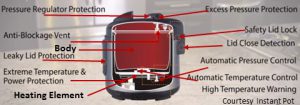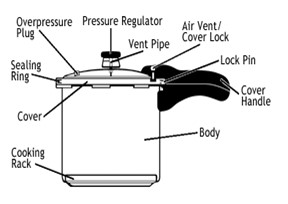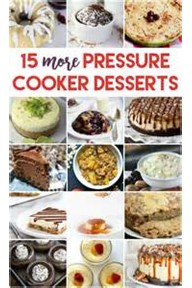What Is A Pressure Cooker Top Nine Facts
Learn What A Pressure Cooker Is
Discover Features, How They Work, Benefits and Proper Usage To Avoid Safety Mishaps

Stop worrying about using a pressure cooker because you think they are unsafe. Learn what they are, how they are made, how they work and how to use them, and you will be anxious to use them too because they offer eight measurable benefits and so many safety features to prevent a mishap.
What Is A Pressure Cooker?
The pressure cooker is a small kitchen appliance that relies on steam pressure to cook food for a determined period of time. The amount of pressure and the time period of pressure is defined by the kind of food being cooked. The person using the cooker determines the time and pressure.
The heat which produces the steam comes from one of two sources. Either the cooker is plugged in directly to the wall socket which provides direct electrical current or it comes from a cook top surface which heats the container from the bottom up.
The container is usually made of stainless steel or aluminum. Both metals conduct heat well. The cover contains the mechanisms to regulate the steam produced by the heat.
How Is It Made?
Construction Is King
Stove Top Cooker Construction
 Aluminum is a better heat conductor; however if a stainless steel body includes a bi metal base with a bottom outside welded disk of aluminum, heat will conduct well. Without an aluminum layer in the base known as the cooking rack in the diagram, hot spots easily occur which means uneven cooking. Both types of bases are used; however the stainless steel base seems to be most popular and has been constructed to prevent uneven cooking.
Aluminum is a better heat conductor; however if a stainless steel body includes a bi metal base with a bottom outside welded disk of aluminum, heat will conduct well. Without an aluminum layer in the base known as the cooking rack in the diagram, hot spots easily occur which means uneven cooking. Both types of bases are used; however the stainless steel base seems to be most popular and has been constructed to prevent uneven cooking.
Counter Top Cooker Construction

The heating element is found under the body of the cooker as shown in the diagram below. The cooking body is generally stainless steel. The body is plugged into a wall socket.
How Does It Work?
A small amount of liquid is required to create the steam which cooks the food. The amount of liquid required is defined by food recipe type; however much less liquid is need than when using the conventional method because the air inside the cooker is displaced with steam.
Stove Top Cooker Pressure Controlling Mechanisms

Safety is controlled by the cover locking system and the pressure valve. Look for the UL listing which ensures a cover locking system is present to prevent the cover from being opened when there is still pressure inside the cooker. Some cookers have an additional feature that prevents pressure to build up if the cover is not closed properly. The pressure regulator controls the release of excess steam during the cooking process.
The sealing ring prevents steam from escaping where the pot and lid meet. The rubber gasket like ring fits into the cover of the pressure cooker creating a secure seal during cooking. Over time the gasket does wear out. Heat exposure causes the sealing ring to shrink or become deformed. When this happens the ring must be replaced to guarantee top performance.
Steam flows through the vent pipe and out from the pressure regulator. The vent pipe must be kept clean. Every time the cooker will be used, the vent pipe must be checked for clogging particles which would prevent the steam from flowing through during usage.
The pressure regulator rocks back and forth during pot usage based on amount of pressure build up in the cooker. It is removable so the vent pipe can be checked for clogging.
The rocking sound caused by the pressure regulator which rocks back and forth based on steam build up is another security features which acts as a reminder the pressure cooker is on.
Double handles help prevent lifting problems. Two handles are better than one and ergonomically designed handles feel better. A six pound cooker will feel light and easy to maneuver when empty however, two handles are necessary to lift a full cooker. Since you are investing in a pressure cooker to last your lifetime, look for ergonomic handles which will provide comfortable and more effective lifting.
Counter Top Cooker Pressure Controlling Mechanisms
A UL listing ensures the minimum required safety precautions have been demonstrated.
The Automatic Pressure Controller controls the pressure while the Pressure Regulator monitors the amount of pressure keeping it in safe range.

The Electrical Current and Temperature Fuse cuts off power if the current or internal temperature exceeds the safety limits. The Excess Pressure Protection releases excess pressure into internal chamber in a dangerous situation
The lid is controlled by a Sensor For Lid Position Detection monitoring whether the lid is in an unsafe position for pressure-cooking. The Smart Detection Of Leaky Lid monitors if the steam release is in open position.
The Automatic Temperature Controller regulates temperature based on the type of program being selected. The High Temperature Monitor warns of excess temperature to prevent burning food. The Anti-Blockage Vent prevents food debris from blocking the vent which releases excess steam.
What Does It Look Like?
Brushed Stainless Steel Body Canister Gives Luster
The outer shell of a majority of pressure cookers is stainless-steel. This makes it shine with luster year after year making any kitchen look rich, elegant, clean and crisp. The outer body is canister shaped.
Some canisters are made of aluminum. Aluminum is dull and easy on the pocket book. Depending upon the size of cooker the price variance can be as much as $50 or more.
Bakelite Handles And Cover Knob
Though the body is canister shaped the cover and handles provide uniqueness and eye catching shape. All covers have a dome shaped rise to accommodate the steam produced; however some are rounded and others are boxed at the top. Of course handles are for lifting therefore they must be made pf a material such as Bakelite which has heat-resistant properties.
Their shape is most eye catching. Some handles are symmetrical like a half shaped oval; others are asymmetrical.
What Size Is Best?

Filling the pot too full causes steam release issues and vent pipe clogging. Only fill the pressure cooker to 1/2 full for recipes that are primarily grain, rice, beans because they swell to twice their size when cooking and create a lot of foam and bubbles. Fill the pot 2/3 full for all other ingredients.
Best cooker size is also determined by meal size prepared. Whole meal recipes for one or two people can be made in a four quart pressure cooker. Families of five or seven can enjoy a whole meal cooked in a six quart cooker. Whole meals cooked for eight or more people should be made in an eight quart cooker. Pressure cookers larger than eight quart are best used for large crowds.
How To Use

Easy steps for using the pressure cooker are outlined below.
Follow the instructions from your manufacturer if they differ from those provided below.
- Select your recipe. Note times required for different food types if making a whole meal recipe.
- Check the vent pipe for clogging by holding the lid up so light shines through.
- Add required liquid per the recipe. One cup is sufficient for many recipes. Too much liquid brings poor results.
- Place the food that requires the longest time in the cooker, usually the meat. Don’t start counting the time cooked until 15 pounds of pressure is reached.
- Partially cook the first food until the remaining time is the same for the rest of the food.
- Before adding the remaining food, determine what to do with any sediments. Using wine to dilute them makes a great gravy or sauce.
- Place the vegetables on the cooking rack for more pronounced flavor. Bring the cooker to fifteen pounds of pressure and continue the cooking process.
- Watching the cooking time is very important to retain food flavor, texture and color.
- Enjoy your whole meal cooked by the pressure cooker.
Right Ways To Open The Hot Lid
- Never run cold water on the cooker to cool it. Too much steam is released and you can get burned.
- Never immerse the base of the cooker in cold water. Doing so causes thermal shock and over time can warp the metals and separate the base from the pot.
- The Ten-Minute Natural Release works well for grains that are not impacted by additional cooking while the pressure in the cooker subsides.
- The Natural Release, which means waiting as much as thirty minutes, is recommended for foods that have foam to prevent spraying of the liquid from the vent pipe. Additionally this method is good for meats and desserts to prevent moisture from evaporating too quickly from them.
- The Quick Release means the pressure valve or pressure releasing mechanism is pushed so steam is allowed to release by human intervention.
Eight Advantages For Using?
- Saves time up to 20 to 60%. The cooking temperature is reached faster, the steam is hotter and the food is ready to eat faster.
- Saves energy up to 70%. The heat in the form of steam is trapped in the cooker without a way of escape because of the seals. The liquid reaches a higher temperature much quicker and the heat is retained to work quickly and effectively.
- Preserves food nutrients. The tightly sealed contained, faster cooking time and usage of less liquid retains the nutrients in the food.
- Saves multiple pan usage for meal preparation. Using a rack inside the cooker provides enough room for an entire meal of vegetables, potatoes and meat. A cooking rack is worth every penny. It allows you to cook foods above and away from the liquid. It prevents the various flavors and odors from intermingling.
- Saves need for multiple small appliances. Many pressure cookers perform multiple functions such as pressure cooker, slow cooker, pasteurizer, rice and porridge cooker, cake baker, yogurt maker, sauté and searer, warmer, sterilizer and steamer.
- Quick Easy Operation. Just press the button on counter top models.
- Saves money. Less energy is used, Initial price seems higher; however since it performs so many functions. There is no need to buy so many small appliances.
- Saves worry of inconsistent results. The pressure, temperature and time is monitored and adjusted by the cooker as needed. The cooking programs have been thoroughly tested for optimal results.
Three Disadvantages For Using?
- The cooker with its food is heavy.
- Opening the cooker to check on the food negatively impacts the benefits listed above.
- Cost will seem high if many small appliances are already owned to perform the multiple functions listed above.
Which Brand Is Best To Buy
The most popular brands are Instant Pot, All American, Cusinart, Culina, Fagor, Prestige, Presto and T-Fall. We have done a comparison of brands and suggest the following brand and model. Check out our recommended best pressure cooker here.
Conclusion
Pressure cookers are safe to use. Look for the UL label. The Underwriters Laboratory has established safety standards to prevent pressure cooker safety mishaps. They save so much time, energy, the need for so many small appliances, and food nutrients. They are a must have for every kitchen. If you are not a committed proud owner, check them out today.
Maybe you have been a long time user and it is time to update to a model that offers so many more cooking options. Indeed the new models are great to use.
Go back to the Pros Cons Shopping home page.